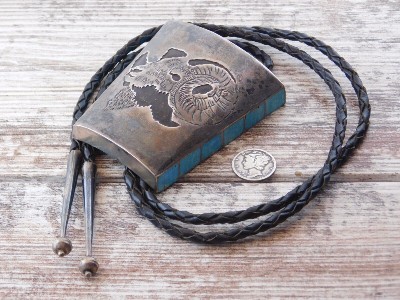Affiliate Disclaimer: We work to provide bolo ties and locate merchants who sell the products you are looking for. If you make a purchase from any of the merchants we endorse, we will earn a small commission at no additional cost to you. Thank you for your support!
Old Pawn Turquoise Bolo Ties and Native American jewelry
 When it comes to vintage Native American jewelry, the term "old pawn" carries significant meaning. In particular, old pawn turquoise bolo ties refer to those that were previously pawned by Navajo, Zuni, or Hopi tribespeople in the early 1900s through 1940s timeframe. Typically made of silver and high quality natural blue or green turquoise, these bolo ties have a distinct place in Southwestern Native culture.
When it comes to vintage Native American jewelry, the term "old pawn" carries significant meaning. In particular, old pawn turquoise bolo ties refer to those that were previously pawned by Navajo, Zuni, or Hopi tribespeople in the early 1900s through 1940s timeframe. Typically made of silver and high quality natural blue or green turquoise, these bolo ties have a distinct place in Southwestern Native culture.In challenging times when cash and goods were scarce, Native silversmiths and artisans would pawn their painstaking handcrafted jewelry at trading outlets or pawn shops to obtain funds or supplies. At pawn shops these pieces would sit unsold for months or years until the right buyer came along-hence why old pawn turquoise ties exhibit gorgeous patinas today. Now those same pawned turquoise and silver bolos from last century are coveted vintage artifacts.
Beyond the nostalgia, there is also incredible variety that appeals to old pawn turquoise bolo collectors. Signature hallmarks denote silversmithing clans like the Begay, Cadman, or Harrison families. Stylized Thunderbird patterns, geometric zigzags, intricate stampwork, and traditional Native heritage symbols reveal artisanal craftsmanship. As wearable history reflecting the Southwest's past and tester to the resilience of its indigenous peoples, genuine old pawn turquoise and silver bolo ties are culturally meaningful pieces that stir admiration.
One major draw is that each vintage piece tells a unique story through its patterns, markings and materials. Collectors passionately analyze details like the style of silverwork, distinct turquoise matrix, or signs of old repaired breaks to gather clues about the tie's past. Determining the Navajo clan silversmith from stamped initials or trying to date the turquoise adds to the intrigue. The pawn tickets themselves become artifacts proving the tie's trade history. Each bolo becomes a historical puzzle to unwind.
The culture and artistry poured into vintage ties also creates value. Traditional symbols like arrows, corn stalks, and Native dancers used by old pawn Navajo silversmith families carry ancestral significance. The techniques for hand-working silver range from intricate stamped beads to elegant overlay designs. Time-honored methods for cutting and shaping gorgeous turquoise stones complete exquisite wearable talismans. This merges beautiful form and deeper meaning that enthusiasts appreciate.
Lastly, the limited quantity contributes to demand. Only the most impeccable museum-grade ties withstand a century without damage. Cracks, small missing stones, and well-worn silver reflect their age and pledge by past tribespeople to one day return. The ability to own an investment-grade piece of Native history over 100 years old becomes a privilege. This bestows old pawn vintage turquoise bolo ties with a cult-like status among avid collectors and historians who relish items of such caliber, scarcity and story.






